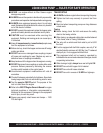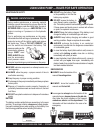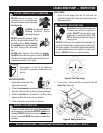
MAYCO LS400/LS500 PUMP — OPERATION AND PARTS MANUAL — REV. #6 (09/19/11) — PAGE 17
LS400/LS500 PUMP — HOW IT WORKS
The following is a brief explanation of how the concrete cylinders,
hydraulic cylinders, shuttle tube, valves and hopper work in
sequence to pump concrete.
The hydraulic pressure is generated by a variable volume,
pressure compensated, axial piston pump that is driven by a
diesel engine. The rod sides of the drive cylinders are
hydraulically connected together creating a “slave circuit,” which
allows hydraulic oil to transfer from one piston to the other.
The two part cycling sequence is initiated by an electrical signal
generated by two proximity switches activated by the drive
cylinder. The proximity switches are normally open, magnetically
sensing the movement of the main drive cylinder. As the drive
cylinder piston head passes the proximity switch, an electrical
signal is sent to the solenoid operated pilot valve which in turn
directs pilot oil to the four valves controlling the drive cylinder
and the shuttle cylinder.
A one-gallon accumulator assists the movement of the shuttle
tube. This circuit assures that the shuttle tube will throw with the
same intensity of each stroke regardless of how fast the main
drive cylinders are cycling.
Figure 3. Pumping Cycle 1
TO TANK
HIGH PRESSURE
OIL FROM PUMP
PROXIMITY
SWITCH
HYDRAULIC
CYLINDERS
PISTON
CUP
CONCRETE
CYLINDERS
SHUTTLE TUBE
SLAVE
OIL
SHUTTLE TUBE MOTION
A
B
In the first cycle, hydraulic pressure is applied to cylinder (B),
causing the hydraulic piston, which is connected to the concrete
piston and piston cup, to discharge concrete into the delivery
line (Figure 3).
As one cylinder is discharging concrete, the hydraulic oil from
the rod side (B) of the drive cylinders is being transferred through
the slave circuit causing the opposite cylinder (A) to move back
on the suction stroke, filling the cylinder with concrete.
The shuttle tube is sequenced to pivot to each concrete cylinder
as the drive cylinders stroke to push concrete. As the second
cycling sequence begins (Figure 4), the shuttle tube pivots to
the opposite cylinder (A). The hydraulic piston passes under the
proximity switch and sends pressure to the piston, causing it to
stroke and discharge concrete into the delivery line. Hydraulic
oil is transferred through the slave circuit to cylinder B, causing it
to start a suction stroke, refilling it with concrete. The pumping
sequence then repeats for the duration of the operation.
Figure 4. Pumping Cycle 2


















